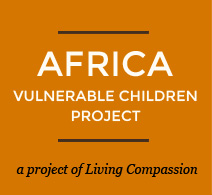Much to accomplish on the last day. I arranged to have Theresa meet me at the guesthouse at 8:45AM so we could get downtown when everything is first opening. We decided to hire Simon, who appears to be our new regular taxi driver, for the whole day. Simon is an old family friend of the Kapendas (Theresa’s family) and embodies all our favorite characteristics in a taxi driver—safe, slow, quiet, and speaks English well. We still miss Muyunda, but it is very nice to have someone we can rely on.
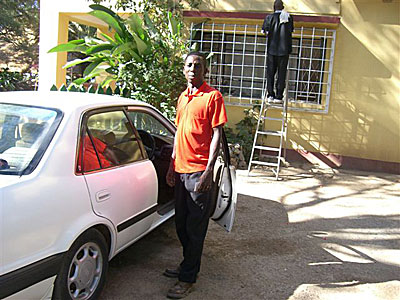
Simon
We went first to the Permanent Secretary’s office to see about getting help acquiring Theresa’s National Registration Card. It is the equivalent of our social security card only more significant in that the actual, physical card is needed for anything official you wish to do. Theresa lost hers a couple years ago and applied for a new one nearly a year ago. We cannot figure out what the hold up is so we decided to get some help.
The Permanent Secretary was in a meeting. While we waited Theresa and I set up her phone with an international call number so she can contact me in the U.S. It is funny how little things like that can be so much fun. To test it we called the Living Compassion landline back at home and on came my voice asking us to leave a message. This, in itself, is a novelty for Theresa, as there is no such thing as answering machines or voicemail here. Theresa left me a message, which will be very fun to receive when I get home. It is reassuring to know she now has a way to get in touch with me quickly if needed.

Theresa testing the call system.
After 45 minutes the Permanent Secretary was still not back from her meeting, but it turned out her secretary was able to assist us. It looks like they will help Theresa take care of it next week. We would be so grateful!
We struck out at two more government offices—everyone seemed to be at off-site meetings—and decided to drop by Dr. Obi’s office to pick up some documents he had for us. He had asked a colleague, who recently opened a clinic, to provide a copy of the government requirements for a health care facility. It is a huge start towards planning for our next steps once the building is complete in Kantolomba.

Nurse Susan poses with her cousin, who happened to be at the clinic when we stopped by.
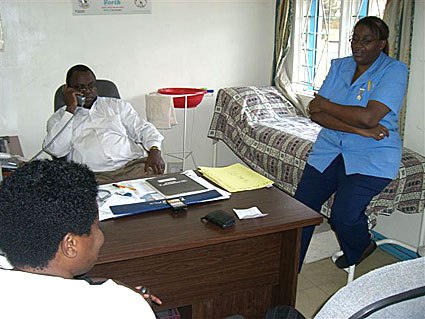
In Dr. Obi’s office.
Before going back to the guesthouse for some lunch, we stopped in town to pick up supplies for Josephine’s baby. We collected all the equipment for bottle-feeding, since breastfeeding would run the risk of passing on HIV to the baby. It will be a first to see a mother in Kantolomba bottle-feeding, and, quite frankly, we feel ambivalent about it. But from the largest perspective we can access it feels like the benefits far outweigh the negatives. Josephine is completely willing for it and was only stalled because of expense. We did the math, and it will cost around $300 to feed the baby formula for a year—a king’s ransom for anyone in Kantolomba and a pittance for most westerners as a price to save a baby’s life.
Theresa and I went back to the guesthouse for lunch. We ordered Theresa some nchima (the maize dish Zambians eat for EVERY lunch and dinner.] I ate the usual vegetarian musunga fare: cheese sandwiches and some frozen veggie burgers. Luckily there are enough vegetarian Indians in town for the local market to carry such products. We had a lovely conversation over lunch about Theresa’s life. It is an everyday story in Zambia but still so extraordinary. What makes it so amazing is that, although the circumstances of her growing up prevented her from realizing her great potential, the miracle of her coming forward to lead the Living Compassion projects in Zambia has, in the end, allowed her to realize her dreams.
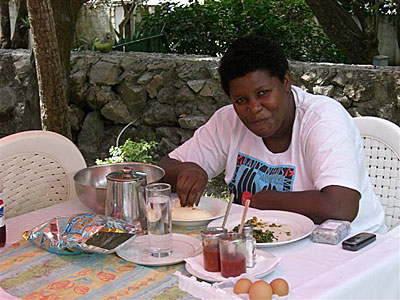
Theresa eating nchima
When I asked her if she has ever considered writing her story, she responded, “Yes, I have. I only would need someone who is very good with English to look it over for me.” I assured her we would be happy to help with that, and she is going to begin to use her Living Compassion laptop to write notes. “I will start from the day I was born,” she said smiling.
After lunch we went to Kantolomba. As we approached we could see the smoke from several little fires some kids had set. Apparently that is common this time of year. There are very tall, dry grasses, and children set the grass on fire to get the grasshoppers to come out. Grasshoppers are considered a delicious treat. When I asked what usually happens with fires (realizing that the chances that a fire truck has EVER been to Kantolomba are about zero), they said people usually just let it burn out. Having houses made with mud brick and tin roofs, fire is not a big danger to the structures. The problem today was that two of the fires were very near our fence, and the women were concerned that the fence might burn. Beauty and Pauline carried jugs of water to one fire while James went up and around the back of the property with a large tree branch to smother a fire back there. Both were successful within minutes!
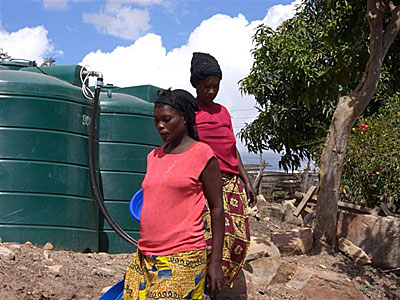
Pauline and Beauty coming down the hill for more water.
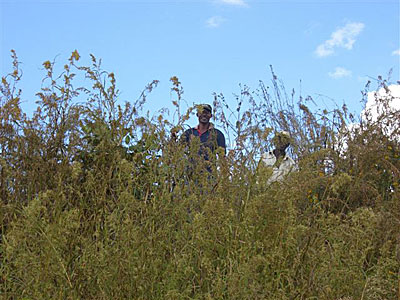
You can barely see James here up in the reeds. He insisted we take
his photo after he was victorious over the fire!
As I was talking to a group of women, I turned around at one point and smiled as I saw 19 flashlights lined up on the roof, bathing in the sun to build up energy to provide light in the women’s houses that night. Theresa said they are thrilled to have them! Each flashlight lay next to some kind of marker—a rock, two rocks, a piece of a plastic bag, an old spring—to denote who it belongs to.
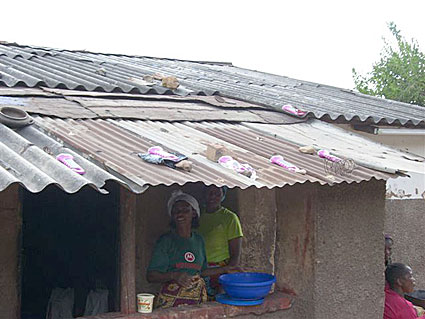
The flashlights charging on the roof.
Before leaving I wanted to take another look at the newest part of our property. Last fall we purchased five more small houses on the right-hand border of our land, nearly doubling the size of the property. We wanted to look through the houses to see which ones might be worth re-roofing in order to save the actual structure. There are some that are clearly going to need to come down, but others may prove salvageable. Luckily we have many months to decide as the rains do not begin again until late October.

An interior wall of one of the houses that is coming down.
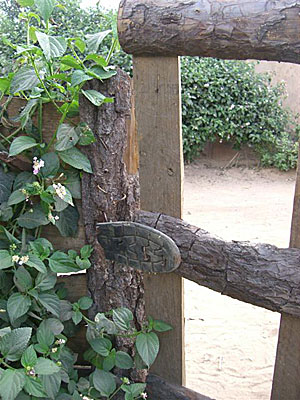
A fabulous gate on the fence of the new property.
Check out the hinge made from the heel of an old shoe!

An outdoor structure for showering at one of the new properties.
Last order of business in Kantolomba was to say goodbye. We sat for a while on the reed mat together—I know we have mentioned any number of times that it is one of our favorite things to do. “We are sad you are going,” one of the women expressed (in Bemba—Theresa translated). “Me too,” I concurred. “But we will be back so soon, the end of June and this time with Cheri.” This elicited great applause and big smiles.
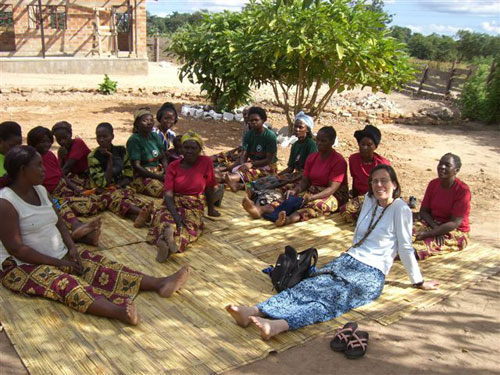
On the reed mat.

Agness comes to say goodbye.
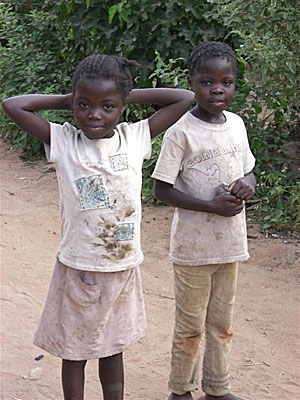
Two girls we greeted on our way out.
On the way back to the guesthouse, we passed through several shops/offices to finish up the rest of the things on our list. It is amazing how somehow we manage to squeak in just exactly what we need to on each trip. The only outstanding item to take care of in the morning on the way to the airport is a stop by the Social Welfare office to pick up a letter for our NGO papers.
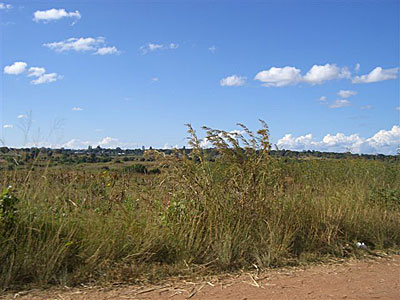
Trying to capture the beauty of the scenes on the drive back into town.
Last chore before turning in for the evening: box up all the things we leave here each trip—our kitchen items, bug repellant, sunscreen, towels, etc. Little by little we are building ourselves a second household here in Ndola, making packing to come here a whole lot simpler.
